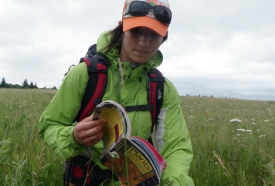Who is training tomorrow’s conservation biologists? The gap between academic and applied conservation

NCC conservation intern monitoring plant communities (Photo by NCC)
As a small group of large black birds soared overhead on a warm summer day, I saw a look of confusion on my new field assistant’s face. I asked her if she was OK, and she commented:
“That’s the third time I’ve seen those birds today. I took two courses in ornithology, and while I understand how birds fly, their anatomy and evolutionary history, I don’t know what species they are.”
This was our first time out in the field, and based on her high marks and rave reference checks from university professors I was under the impression that a degree in biology came with a solid foundation in taxonomy, with at least a basic ecological literacy in local species. I came to learn that not only was my field assistant not able to recognize turkey vultures, but the identification of other common birds and trees were outside of her formal zoological and botanical training.
Species identification certainly isn’t everything when it comes to ecology and conservation (indeed much of the efforts needed in conservation are more about people than other species), but it seems to me that it’s a fundamental building block in developing a comprehensive understanding about conservation needs and priorities. From monitoring, to invasive species control to the inventory and management of rare species, knowledge of individual species and their interactions is essential to understanding how our natural systems work and what we need to do to protect and repair them. The alternative can be a reductionist approach that ignores species' interactions with their habitats and even treats these as externalities as opposed to integrated parts of our complex natural word.
What causes this gap between what students are learning and what conservation practitioners like the Nature Conservancy of Canada (NCC) need? Well, to start there’s a lot more we could do at NCC. Part of it is raising our profile about the good applied conservation science and research that we already do. By better communicating these results through journals and at conferences, we might be able to find academic partners that can help us with priority monitoring and research.
The other thing we could do is to share the list of important (and, in my opinion very cool) research projects that come out of our ecoregional assessments, conservation plans for our natural areas and management plans for our properties. These projects include literature searches, identifying best management practices and supporting long-term ecological monitoring.
We do have some great relationships with many universities and colleges, but in a world that is putting more and more demands on our biodiversity, we need to be more proactive about creating and fostering these relationships so that we can find solutions to pressing and often urgent real-world problems. Theories and theoretical ecology are important, but without application and on-the-ground relevance, they do little but fill the pages of journals.
What universities can do is to look at ways to apply the resources and amazing talents they have to help organizations make the best use of the limited funds we have for conservation. What passionate emerging ecologist wouldn't want to put their academic efforts into something that will help real-world conservation?


